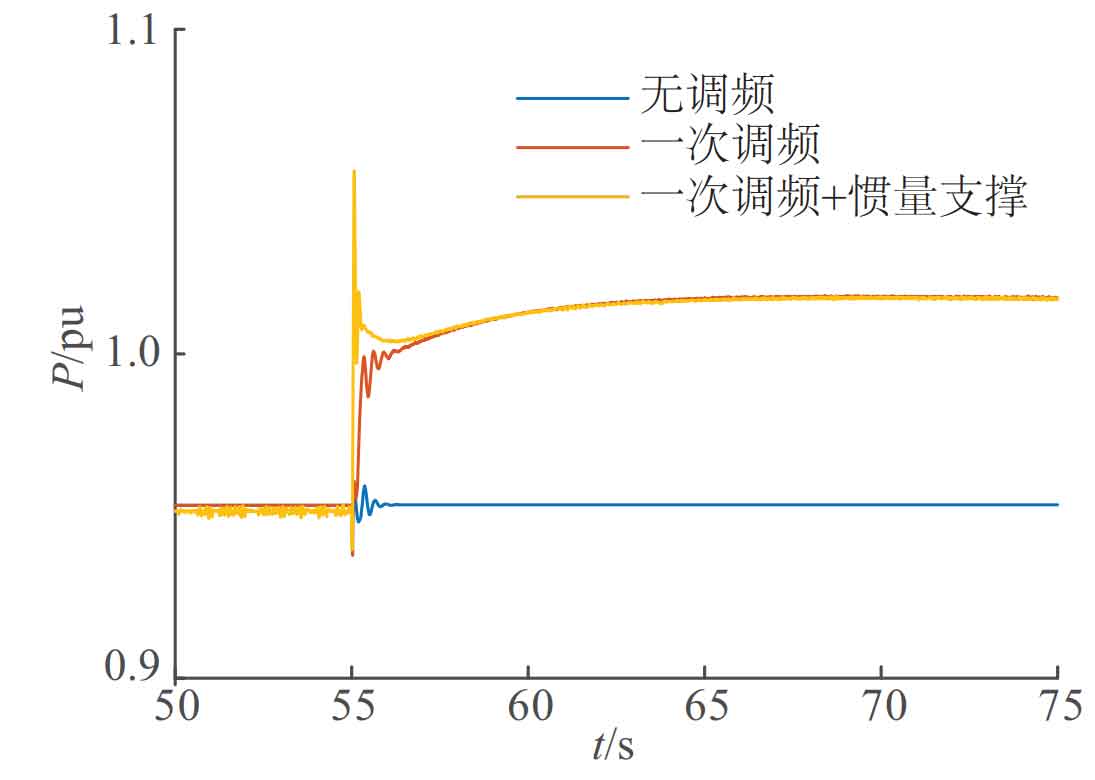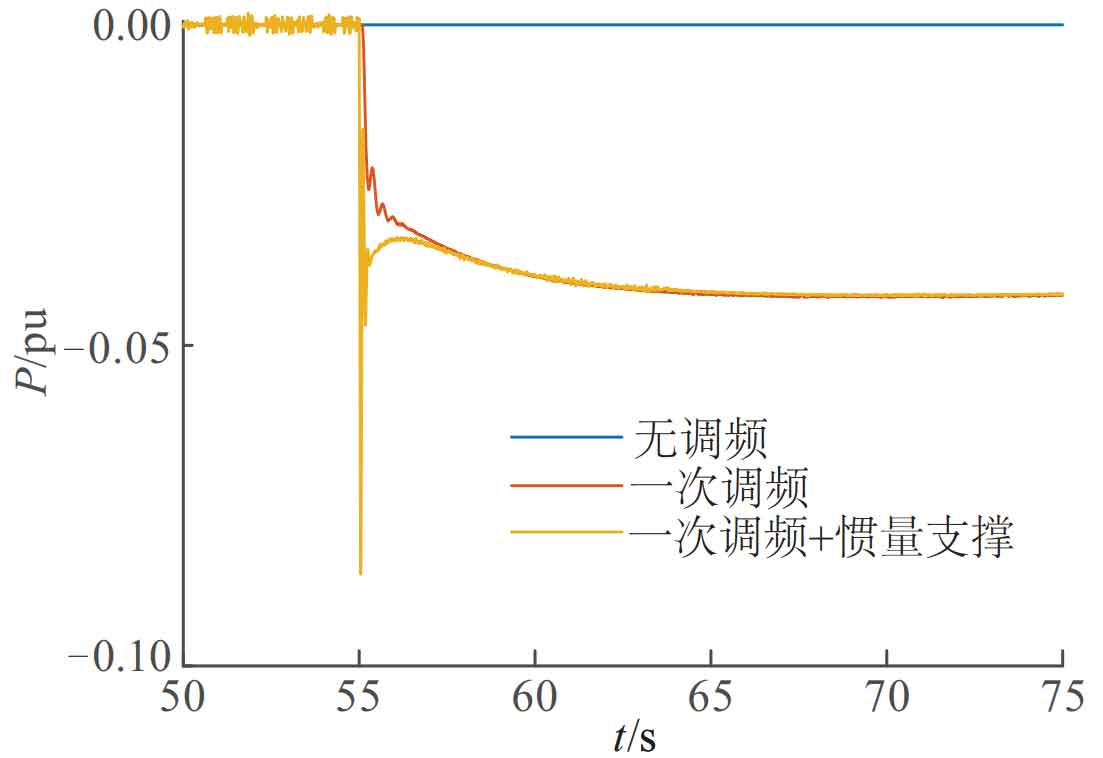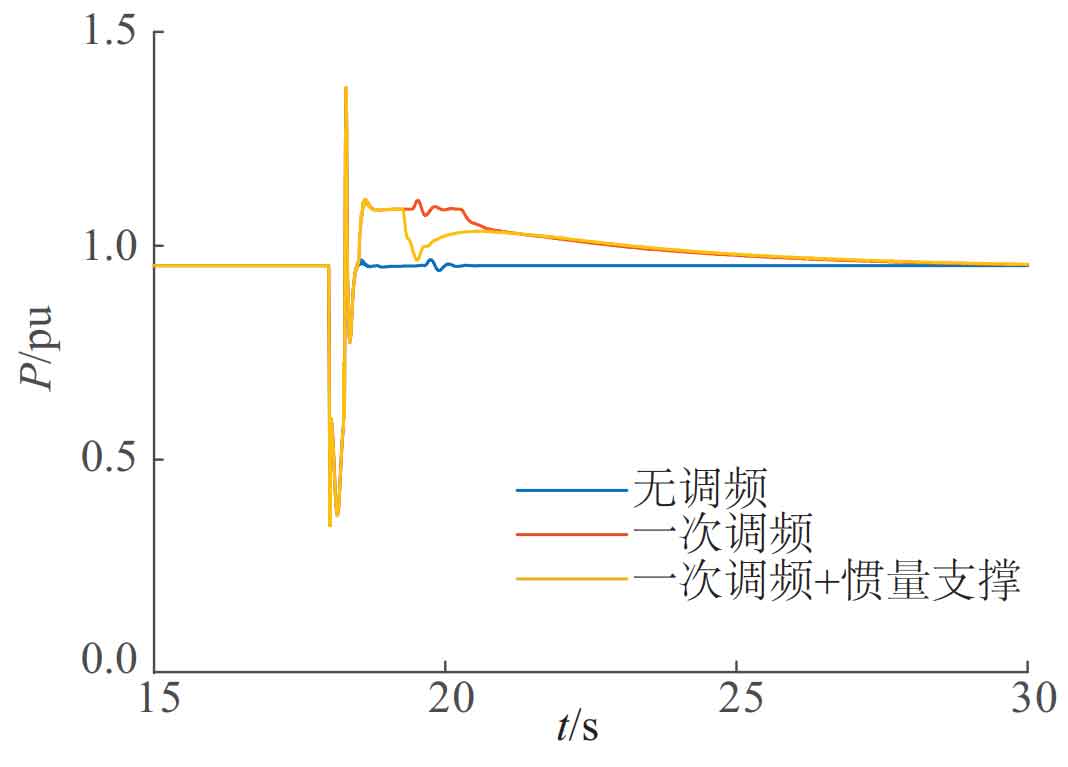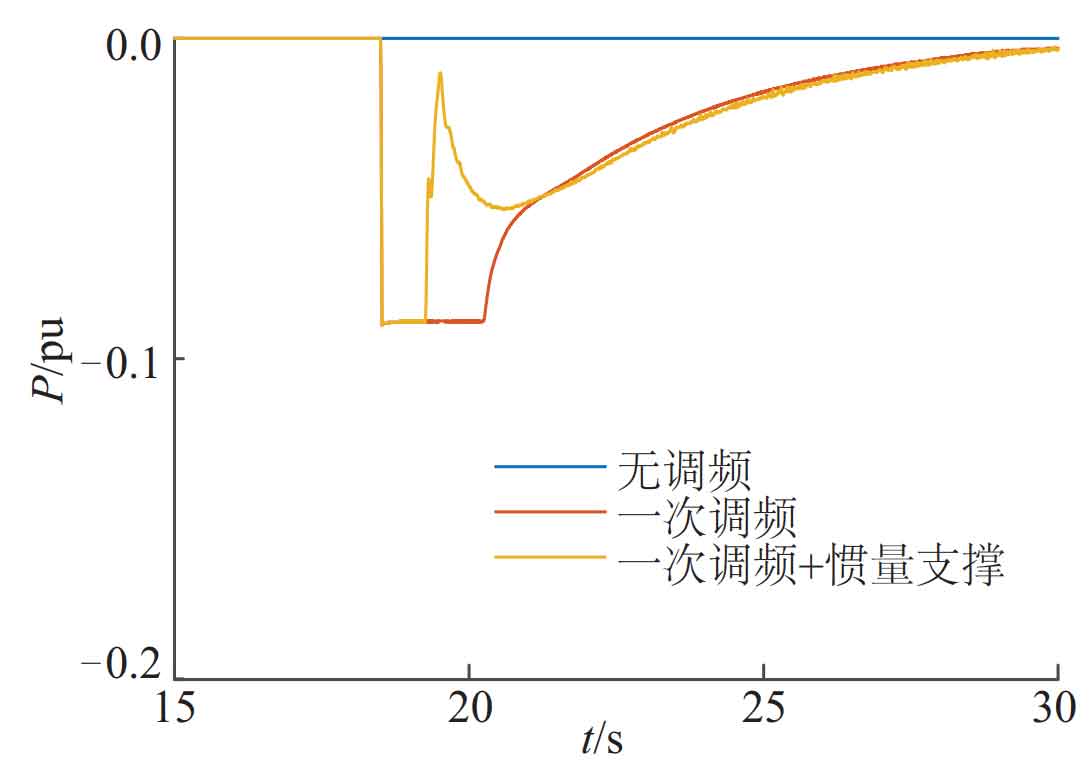According to data from the National Energy Administration, since the end of 2015, China’s photovoltaic installed capacity has been ranked first in the world and showing a growing trend. As of the end of 2021, the cumulative installed capacity of photovoltaics in China has reached 305.987 GW; By 2030, the total installed capacity of photovoltaic and wind power generation will reach over 1.2 billion kW. Photovoltaic units will be the mainstream power generation units in the future. As the penetration rate of new energy increases, the frequency stability of the power system deteriorates and is susceptible to power fluctuations and faults. In addition, the ability of photovoltaic units to withstand faults is lower than that of traditional synchronous generator units, and they are prone to grid disconnection accidents when encountering fault disturbances. In 2021, the European power grid experienced a significant shift in power flow towards adjacent lines due to the tripping of busbars and circuit breakers, ultimately causing two grid disconnection accidents, resulting in significant frequency fluctuations. The first accident experienced power angle instability, and the second accident triggered a low-frequency load shedding system.
In 2016, during the “9.28” South Australia power outage, the system encountered extreme weather and new energy units unexpectedly disconnected from the grid, resulting in an increase in the active power shortage of the power grid. However, the proportion of new energy in the system is high, and the overall rotational inertia is insufficient to provide sufficient energy support to the power grid in an instant. The system’s frequency change rate is too large, resulting in low-frequency load shedding protection blocking. This causes a large amount of active power shortage to be transferred to the interconnection line, which breaks down due to overload, leading to system frequency collapse. In the 2019 “8.9” UK power grid accident, a high proportion of new energy power systems were hit by lightning, and the system frequency dropped to trigger low-frequency load shedding actions, resulting in a major power outage.
In response to the issue of photovoltaic units being prone to grid disconnection under fault disturbances, the national standard GB/T 19964-2012 stipulates that when subjected to low voltage faults, photovoltaic units should be able to operate without grid disconnection within a certain voltage drop range and time range. According to the requirements of the national standard for system response in case of abnormal grid voltage and the output characteristics of photovoltaic power supply, a photovoltaic low voltage ride through control strategy is studied with the goal of ensuring three-phase grid connected current. To suppress the negative sequence current of grid connection as the control objective, a low voltage ride through strategy for photovoltaic units is studied. A low voltage ride through strategy for photovoltaic power plants is studied with the goal of ensuring three-phase current symmetry and unit power factor input while the photovoltaic power plant operates without disconnection when the grid side voltage drops. We have studied photovoltaic low voltage ride through control strategies to reduce the risk of voltage unit disconnection during grid failures; However, no research has been conducted on how to improve the frequency stability of the system after encountering faults. Research on control strategies for active and reactive currents during low voltage ride through periods in photovoltaic high permeability systems with prominent frequency stability issues. We have studied the power characteristics of photovoltaic power generation during the fault period and during the recovery process, and improved the control strategy of photovoltaic power generation units. However, existing fault traversal control methods focus on reactive power support during fault traversal and active power recovery rate during fault recovery, without paying attention to frequency regulation under faults. In large-scale photovoltaic grid connected systems, although fault traversal of photovoltaic units has been achieved and voltage support can be provided to the system, the problem of transient frequency drop in the system is serious. If the photovoltaic system does not participate in frequency regulation during the fault period, as the photovoltaic penetration rate increases, the system frequency stability becomes worse, and there is a possibility of severe frequency drop that triggers the low-frequency load shedding protection action of the system, leading to power outage accidents.
At present, there are two methods for photovoltaic power stations to have primary frequency regulation and inertia support capabilities: active backup and configuration of energy storage. The cost and maintenance cost of configuring energy storage schemes are relatively high; The active backup scheme does not require additional devices and allows photovoltaic units to participate in grid frequency regulation separately, but its disadvantage is that it will lose some power generation benefits. A flexible power control algorithm was studied for active reserve control. Propose a photovoltaic power generation participation in grid frequency regulation method using variable load shedding control, which can adjust the load shedding rate by changing the frequency of the grid connection point, thereby achieving the goal of flexible frequency adjustment. Propose to connect photovoltaic units to the power grid through virtual synchronous machine control technology without energy storage, and verify its feasibility in parallel and off grid mode. We conducted on-site experiments on fast primary frequency regulation using an active backup scheme. Due to the step size and response speed of the power tracking algorithm, the inertia support effect reflected in the active reserve scheme is weak and difficult to apply in practical engineering. The integrated installation of energy storage devices and photovoltaic units has applications in frequency regulation and peak shaving, as well as in suppressing output fluctuations. Research has found that adding energy storage equipment to photovoltaic units can solve the problem of photovoltaic power fluctuations, resulting in smoother power output in a short time scale; Photovoltaics participate in frequency regulation, allowing their active output to follow frequency fluctuations and achieve bidirectional power regulation; It can also suppress the power oscillation of photovoltaic units and avoid the risk of large amplitude oscillation. However, no research has been conducted on the methods for photovoltaic units to have frequency regulation capability under fault disturbance conditions.
| Photovoltaic penetration rate/% | Generators replaced by photovoltaics | Corresponding photovoltaic units |
| 0 | – | – |
| 33 | G3 | Optical storage system 2 |
| 66 | G3,G1 | Optical storage system 1 and 2 |
Energy storage devices are generally divided into batteries, superconducting energy storage, supercapacitors, flywheels, and compressed air. From Table 1, it can be seen that supercapacitors, batteries, and flywheel energy storage are all suitable for fast frequency modulation, and their selection mainly considers economic benefits and scenario applicability. Supercapacitors have the characteristics of high power density, long cycle life, fast response speed, and certain load-bearing capacity for overcharging and discharging. They can be used to suppress photovoltaic power fluctuations, quickly respond to frequency changes, and other occasions. Therefore, while meeting the transient frequency stability requirements of the system, taking into account both lifespan and power cost indicators, this paper adopts supercapacitor energy storage to assist in frequency regulation of photovoltaic units, and proposes a control strategy that is suitable for both load fluctuations and system frequency changes caused by fault disturbances. This control strategy considers that during the fault period, the voltage drop is severe and the active power cannot be sent out, and it is necessary to ensure that the photovoltaic unit provides dynamic reactive power support to the power grid. In the fault recovery stage, the frequency can recover to the normal operating value. Therefore, it is proposed to use the energy storage auxiliary photovoltaic unit primary frequency regulation control strategy in the fault recovery stage; After being disturbed by a sudden increase in load, the system frequency will experience a drop phenomenon. Due to the power difference, the frequency cannot return to the normal operating value. Therefore, it is proposed to provide primary frequency regulation power and inertia support power through energy storage to assist photovoltaic units in primary frequency regulation and inertia frequency regulation, thus meeting the frequency adjustment requirements under various working conditions. This has certain reference significance for improving the transient frequency stability of large-scale photovoltaic power generation systems.
1.Research on Frequency Modulation Control Strategy for Energy Storage Assisted Photovoltaic Units
Supercapacitors have the characteristics of fast response speed, high charging and discharging times, and high power density, making them suitable for suppressing photovoltaic power fluctuations and quickly responding to frequency changes. In order to meet the needs of transient frequency regulation in the power system, an energy storage device based on supercapacitors is used to assist photovoltaic units in frequency regulation. The supercapacitor is connected to the DC side busbar of the photovoltaic unit through a DC to DC converter (DC/DC converter). The inverter converts the electrical energy output from solar cells and energy storage devices according to system requirements. In addition to participating in the primary frequency modulation process, the supercapacitor energy storage device can also provide fast inertia power support, which can use frequency deviation feedback for primary frequency modulation and primary frequency modulation power reference value Δ Psc 1 is shown in equation (1); Using frequency differentiation for inertia frequency modulation, the inertia supports the reference value of power Δ Psc 2 is shown in equation (2). The overall control block diagram of the energy storage device is shown in Figure 1.
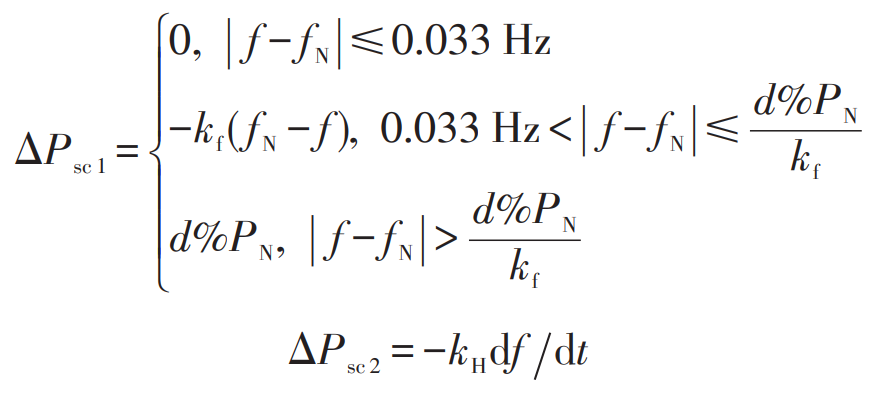
In the formula: f – actual frequency; FN – rated frequency; Kf – primary frequency modulation coefficient; PN – Rated power of photovoltaic inverter; D% PN – energy storage reserve power; KH – virtual inertia coefficient.

To prevent overcharging or discharging, the energy storage system needs to constrain the state of charge (SOC) value of the battery, as shown in equation (3).

In the formula: eSOCmin – lower limit value of energy; ESOCmax – Upper energy limit value.
Due to the role of inertia support in preventing frequency changes in the system, when the system frequency is below normal, inertia support can prevent the frequency from continuing to decrease, but it will suppress the recovery of frequency; When the system frequency is higher than the normal value, inertia support can prevent the frequency from continuing to rise, but it will suppress the frequency from falling back to the normal value. Therefore, under different operating conditions, the role of inertia support in improving system frequency stability varies, and energy storage devices should also adopt different frequency modulation control strategies for different operating conditions.
1.1 Energy Storage Assisted Photovoltaic Unit Frequency Modulation Control Strategy during Load Fluctuation
When the load fluctuation causes the system frequency to exceed the frequency modulation dead band (frequency offset within ± 0.033 Hz), in order to reduce the quasi steady-state frequency deviation and suppress rapid frequency drop, the supercapacitor energy storage system should assist the photovoltaic unit in primary frequency modulation and inertia support, that is, discharge based on the sum of the primary frequency modulation power reference value and inertia support power reference value, i.e. Psc ref= Δ Psc 1+ Δ Psc 2. When the frequency does not exceed the frequency regulation dead band, without the need for energy storage devices to assist the photovoltaic unit in frequency regulation, the energy storage system performs constant power charging (Psc ref=Psc 0) to maintain SOC at eSOC max.
1.2 Energy Storage Assisted Photovoltaic Unit Frequency Modulation Control Strategy in Case of Fault
According to the Technical Regulations for Connecting Photovoltaic Power Stations to the Power System, photovoltaic power stations should have low voltage ride through capability, as shown in Curve 1 in Figure 2. The low-voltage ride through process of photovoltaic units can be divided into normal operation stage, fault period stage, and fault recovery stage based on the voltage response of the grid connection point. The fault period is from the moment of voltage drop at the grid connection point to the moment of voltage recovery to 0.9 pu; From the moment when the voltage recovers to 0.9 pu until the system recovers to the operating level before the fault, it is the fault recovery stage, as shown in curve 2 in Figure 2.
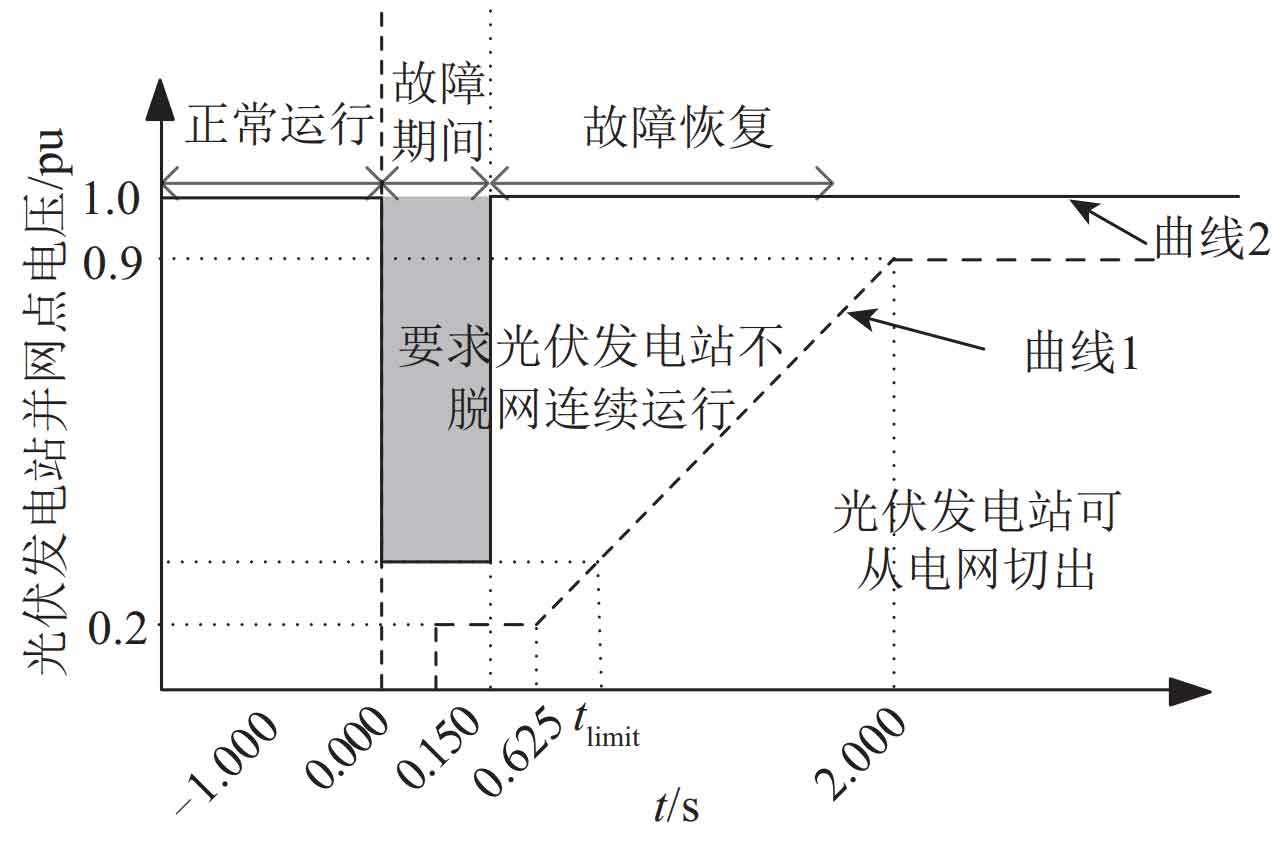
During the fault period, the voltage drop at the grid connection point was severe, and the active power output from the photovoltaic power station could not be transmitted to the grid. Therefore, during the fault period, the priority of voltage adjustment in photovoltaic power plants is higher than frequency adjustment. Without the need for energy storage devices to assist in frequency regulation of photovoltaic units, the energy storage system performs constant power charging (Psc ref=Psc 0) to maintain SOC at eSOC max. When the fault is cleared, the voltage can quickly recover to 0.9 pu, but the frequency cannot be immediately restored due to the long response time of the frequency regulator and the rotor speed. Therefore, during the fault recovery stage, the energy storage device needs to start assisting the photovoltaic unit in frequency regulation. When the system experiences a malfunction and the frequency is below normal, the photovoltaic unit participates in frequency regulation in order to quickly restore the frequency to normal operating levels. In the fault recovery stage, the frequency begins to rise, and inertia support will prevent the frequency from rising and suppress the rapid recovery of the frequency. Therefore, only the energy storage system needs to assist the photovoltaic unit in primary frequency regulation, and the supercapacitor energy storage system discharges based on the power of primary frequency regulation, i.e. Psc ref= Δ Psc 1. During the discharge process, if eSOC (t) ≤ eSOC min, stop discharging; During the charging process, if eSOC (t)>eSOC max, stop charging.
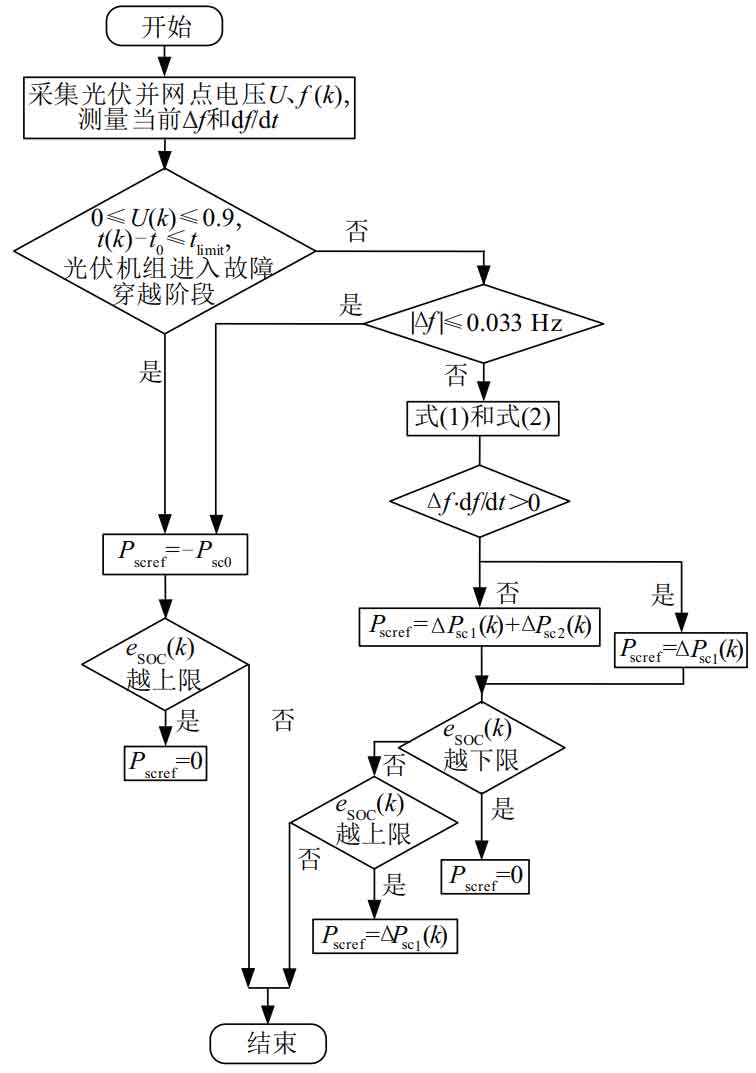
In summary, the frequency regulation control strategy proposed in this article for energy storage auxiliary photovoltaic units is to perform primary frequency regulation and inertia support for the energy storage auxiliary photovoltaic units in case of load fluctuations in the system; When there is a fault disturbance, the energy storage only assists the photovoltaic unit in one frequency modulation. The frequency modulation control flowchart is shown in Figure 3, where t0 represents the moment of voltage drop and tlimit represents the longest allowed period of voltage drop. Therefore, the overall model of the photovoltaic system with energy storage devices is shown in Figure 4. The fault control strategy of photovoltaic inverters is to ensure that the inverter prioritizes the output of reactive current that meets national regulations within the total current limit range, while also considering the output of active current. The energy storage control strategy is shown in Figure 4.
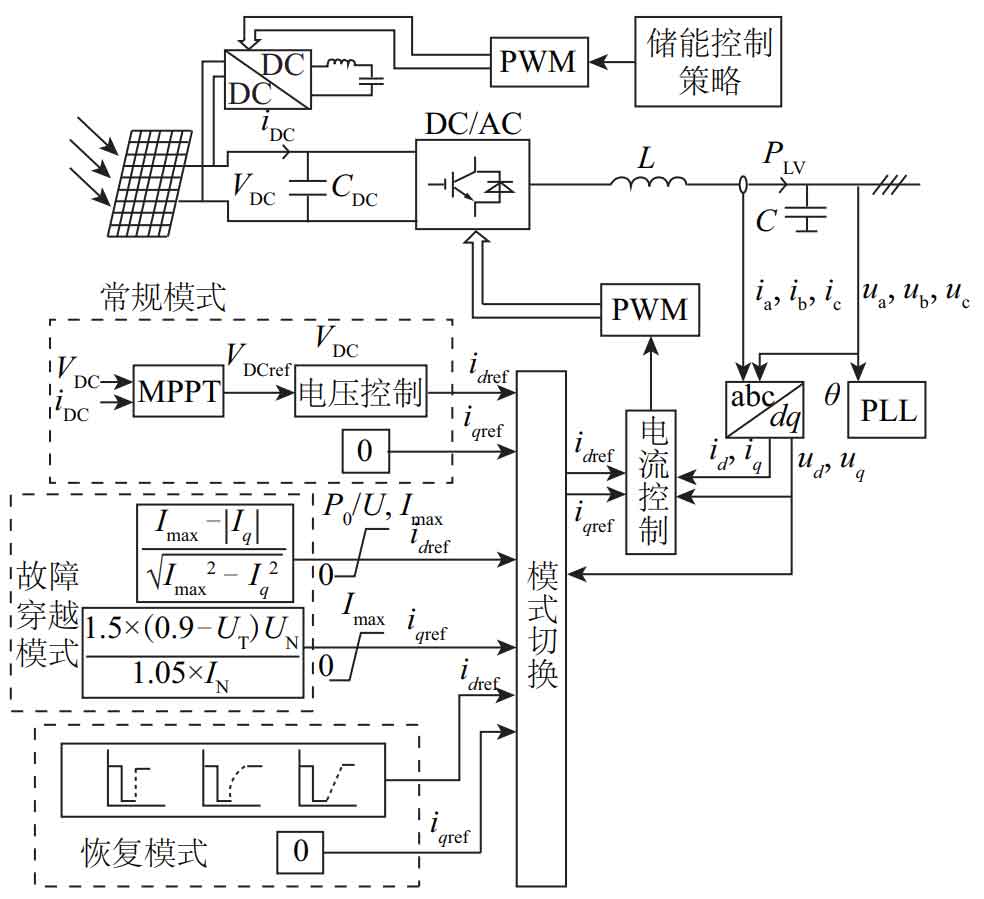
2.Simulation verification
To verify the correctness of the proposed energy storage assisted photovoltaic unit frequency modulation control strategy, a total model of the optical storage system as shown in Figure 5 was built on the Matlab/Simulink simulation platform. The operating characteristics of photovoltaic units and system frequency response were observed in different simulation scenarios, and frequency indicators were used for quantitative evaluation.
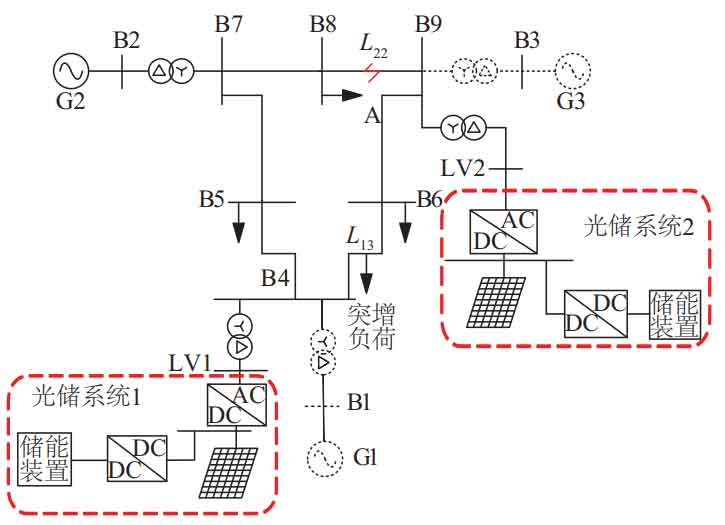
To maintain the injected active power of each node in the original system unchanged, the synchronous generator is directly turned off and replaced by a photovoltaic power plant PV with the same output at the same location, constructing a system with different photovoltaic permeabilities. The synchronous units replaced and the photovoltaic units replaced under different permeabilities, as well as the equivalent parameters of the system, are shown in Table 1. The parameters of each synchronous generator in the system are shown in Table 2, and the parameters of each photovoltaic generator unit are shown in Table 3. The energy storage device is connected to the DC side bus capacitor of the photovoltaic unit through a DC-DC converter. In its frequency modulation control module, the inertia control coefficient KH is 5, and the droop control coefficient KD is 7.5. The capacitance value of the energy storage (supercapacitor) is 93 F, the rated voltage is 750 V, and the initial voltage is 500 V.
| Alternator | Generatrix | P/MW | SN/MVA | Adjustment coefficient/pu | Inertia time constant/s |
| G1 | B1 | 35.48 | 200 | 5 | 6.02 |
| G2 | B2 | 138.80 | 200 | 5 | 12.80 |
| G3 | B3 | 134.40 | 200 | 5 | 6.02 |
Under various photovoltaic permeability conditions, the system is set to experience fault disturbances and sudden load increase disturbances. The fault disturbance is specifically set as a three-phase short circuit fault occurring on the L22 line between bus 8 and bus 9 at 17 seconds, lasting for 250 ms, and the fault clearing line resumes normal operation at 17.25 seconds. The specific disturbance of the sudden increase in load is the sudden increase of 30 MW of active power in line L13 between bus 4 and bus 6 at 55 seconds.
| Optical storage system | Parallel busbar | S/MVA |
| PV1 | B4 | 200 |
| PV2 | B9 | 200 |
Figure 6 shows the PV operation curve under different permeability conditions under fault disturbance. After the photovoltaic grid connected system is disturbed by faults, the DC side voltage increases. Due to its own operating characteristics, the photovoltaic unit can automatically adjust the active power output, achieving a balance between the photovoltaic output active power and the input system active power, thereby achieving low voltage ride through. But after the fault is cleared, there will be a brief drop in the DC side voltage and fluctuations in the active power. After the low voltage ride through is completed and the system reaches stability, the photovoltaic unit returns to the maximum power operating point and outputs the maximum active power.
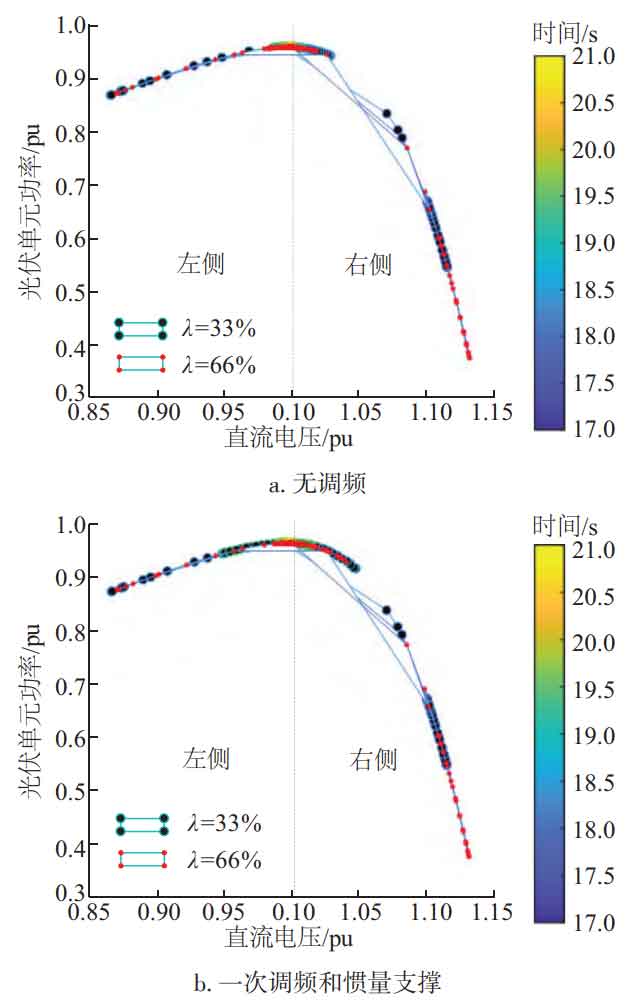
By comparing and observing the power output curves of different control strategies under the same photovoltaic penetration rate in Figure 6a and Figure 6b, it can be seen that the participation of energy storage assisted photovoltaic in frequency modulation control has almost no impact on the DC bus voltage, and thus does not affect the output characteristics of photovoltaic units during the low voltage ride through process. However, from Figures 6a and 6b, it can be seen that as the photovoltaic penetration rate increases, the system stability decreases, and the corresponding photovoltaic unit operation trajectory and fluctuation range are larger, mainly manifested in the right part of the maximum power point.
2.1 Non energy storage systems subject to load fluctuations and fault disturbances under different photovoltaic permeabilities
With the increase of photovoltaic permeability, the system’s rotational inertia decreases, the primary frequency modulation ability weakens, and frequency stability deteriorates. As shown in Figures 7 and 8, regardless of whether the system is subjected to fault disturbances or load fluctuations, the depth of frequency drop decreases with the increase of permeability. As shown in Figure 7, under load fluctuation conditions, there is a power shortage in the system, and the frequency cannot return to the original operating level. Moreover, as the permeability increases, the quasi steady-state frequency deviation increases, and the time to reach steady-state also increases. As shown in Figure 8, under fault disturbance conditions, the system voltage and power can quickly recover to normal operating levels after the fault is cleared, while the frequency still needs some time to recover to normal values, and as the permeability increases, the longer the required time.
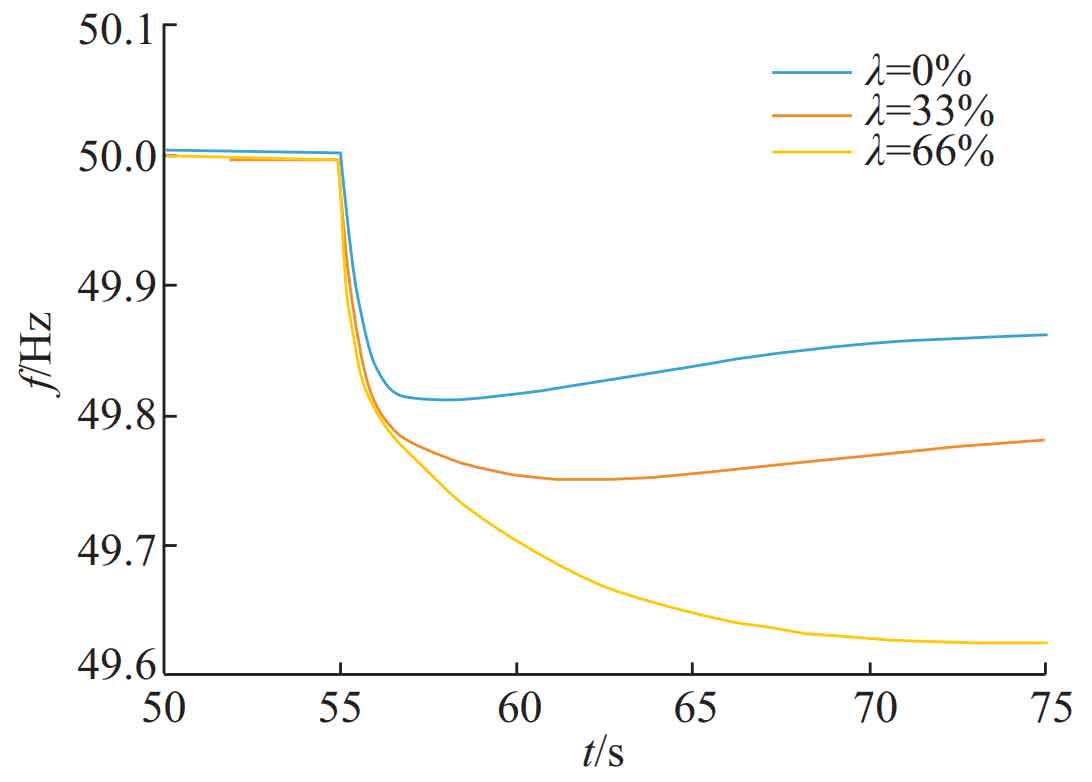
Under two operating conditions with a penetration rate of 33% and 66%, simulation comparative analysis was conducted on the dynamic response of photovoltaic power plants under three control strategies: not participating in frequency regulation, primary frequency regulation of energy storage auxiliary photovoltaic units, and primary frequency regulation and inertia support of energy storage auxiliary photovoltaic units. The dynamic response of the unit at 33% permeability is similar to that at 66% permeability, so a detailed explanation is given based on the simulation condition with a permeability of 66%.
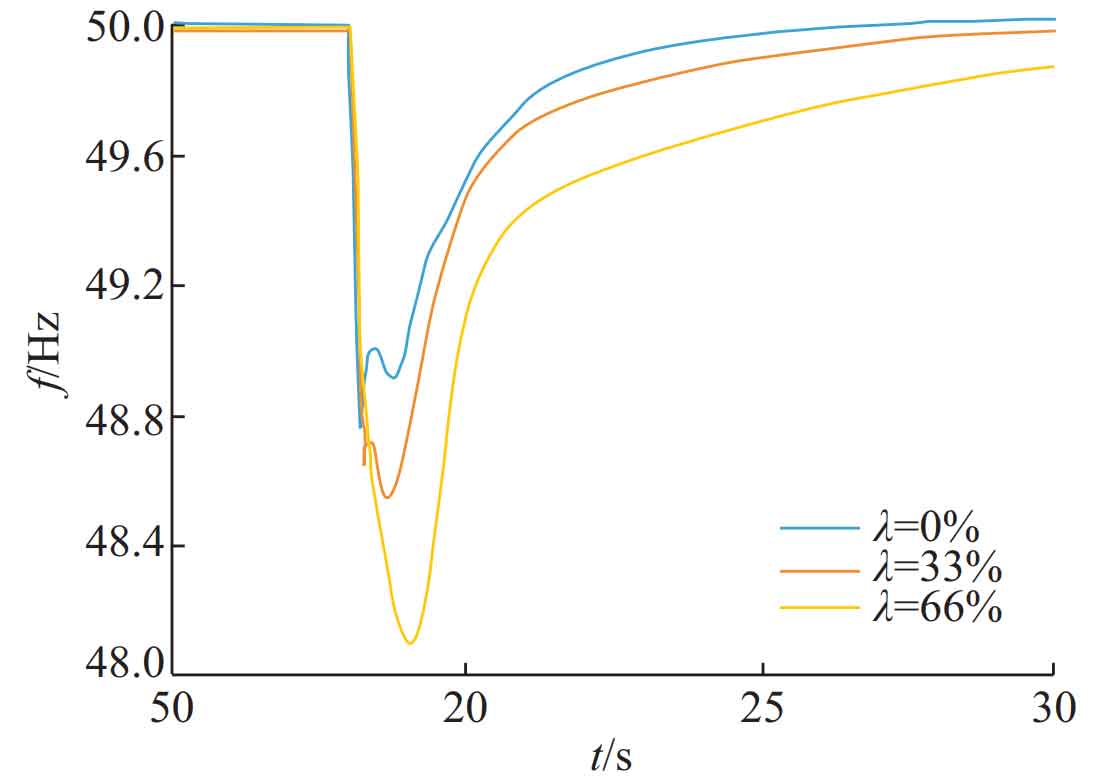
2.2 The photovoltaic penetration rate is 66%, and the system experiences load fluctuations
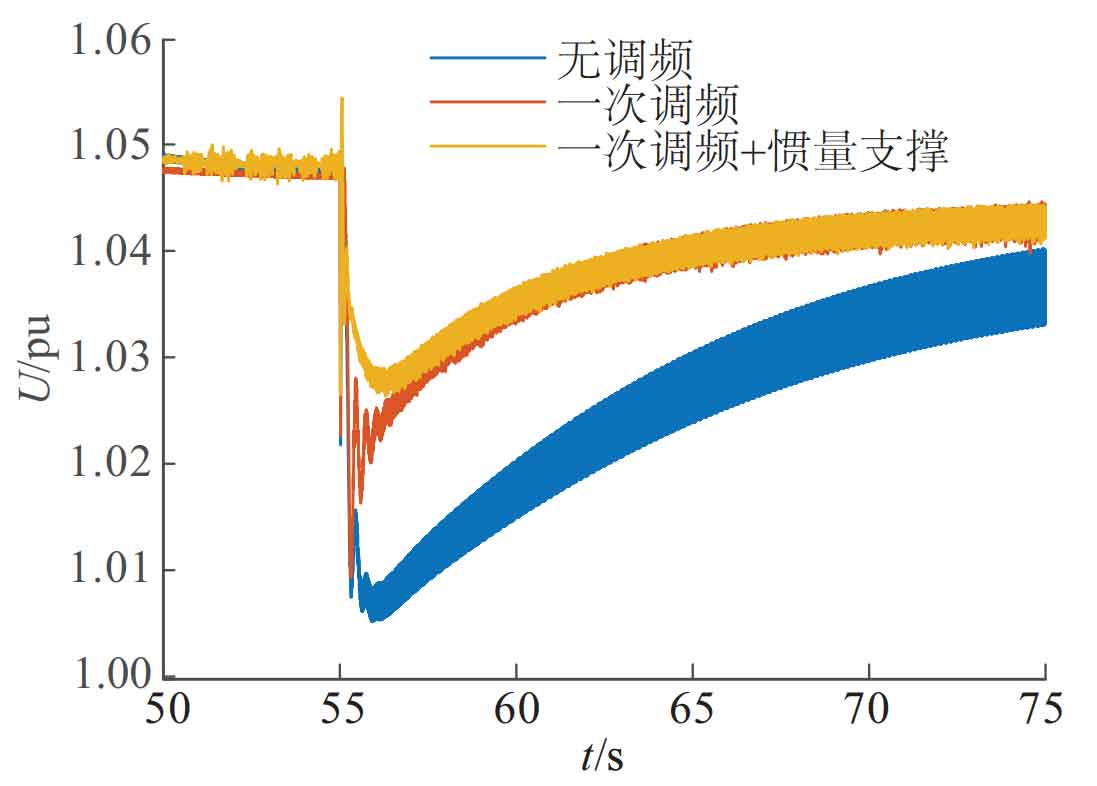
When the system is subjected to sudden load fluctuations, there will be a small range of voltage fluctuations (<0.05 pu), and the photovoltaic unit will not initiate low voltage ride through control, as shown in Figure 9; The frequency will significantly decrease, as shown in Figure 10. Comparing the frequency response curves of the three control strategies in Figure 10, it can be seen that energy storage assisted photovoltaic unit frequency regulation can significantly improve the frequency stability of the system. When energy storage is used to assist in the frequency modulation of photovoltaic systems, the primary frequency modulation coefficients of the two control strategies used are the same, so the steady-state frequency is the same, both of which are higher than the steady-state frequency of photovoltaic systems without energy storage participating in frequency modulation. Due to the fact that inertia can hinder frequency decline, the control strategy of primary frequency regulation and inertia support for energy storage assisted photovoltaic units not only provides primary frequency regulation power to improve frequency stability, but also inertia support power to slow down frequency drop rate. Therefore, the control strategy of primary frequency regulation and inertia support for energy storage assisted photovoltaic units under load disturbances is most conducive to improving the transient frequency stability of the system.
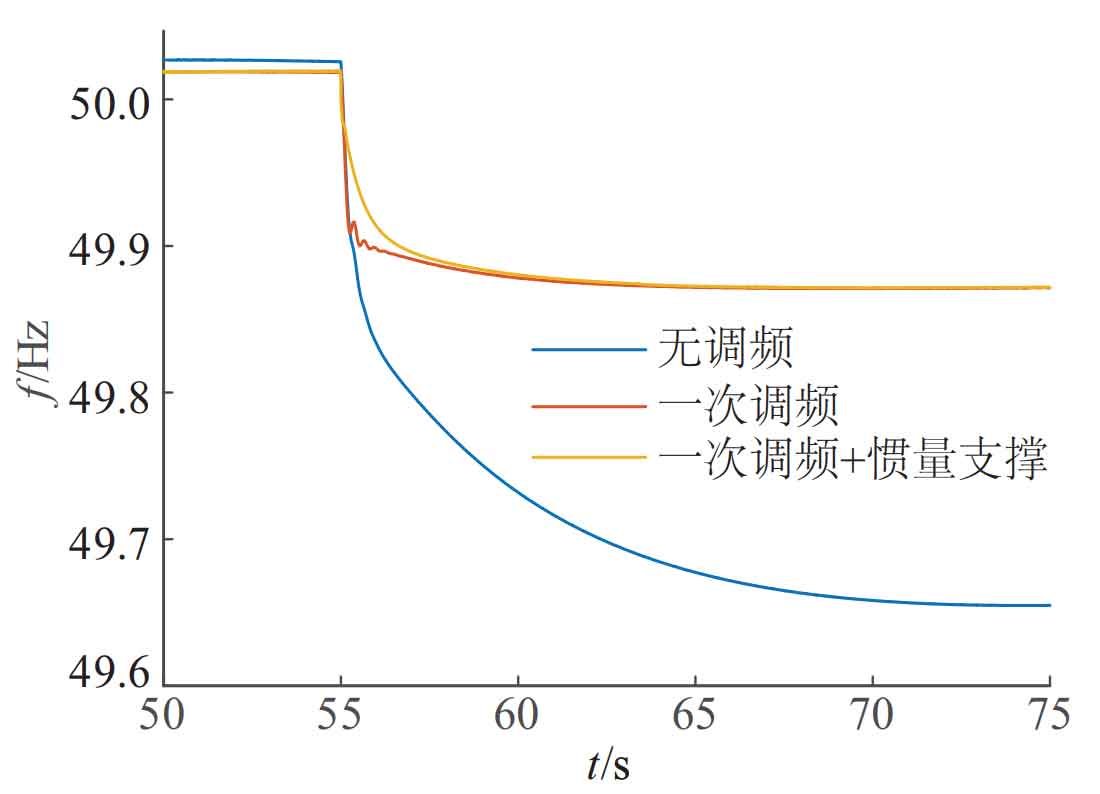
From Figures 11 to 13, it can be seen that once the system frequency drops beyond the frequency modulation dead band, the energy storage device can quickly assist the photovoltaic unit in frequency modulation and provide frequency modulation power.
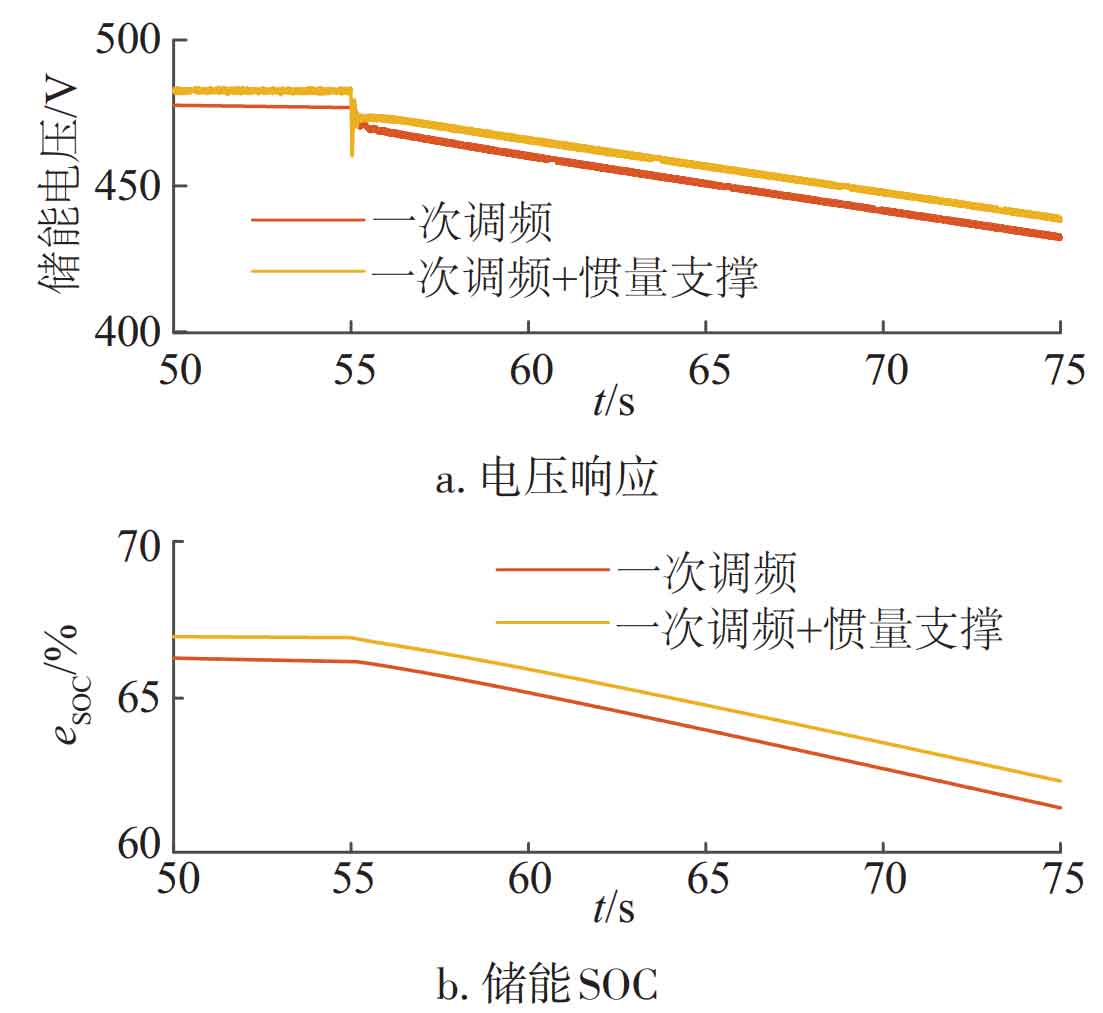
2.3 Photovoltaic penetration rate is 66%, and the system suffers from fault disturbance
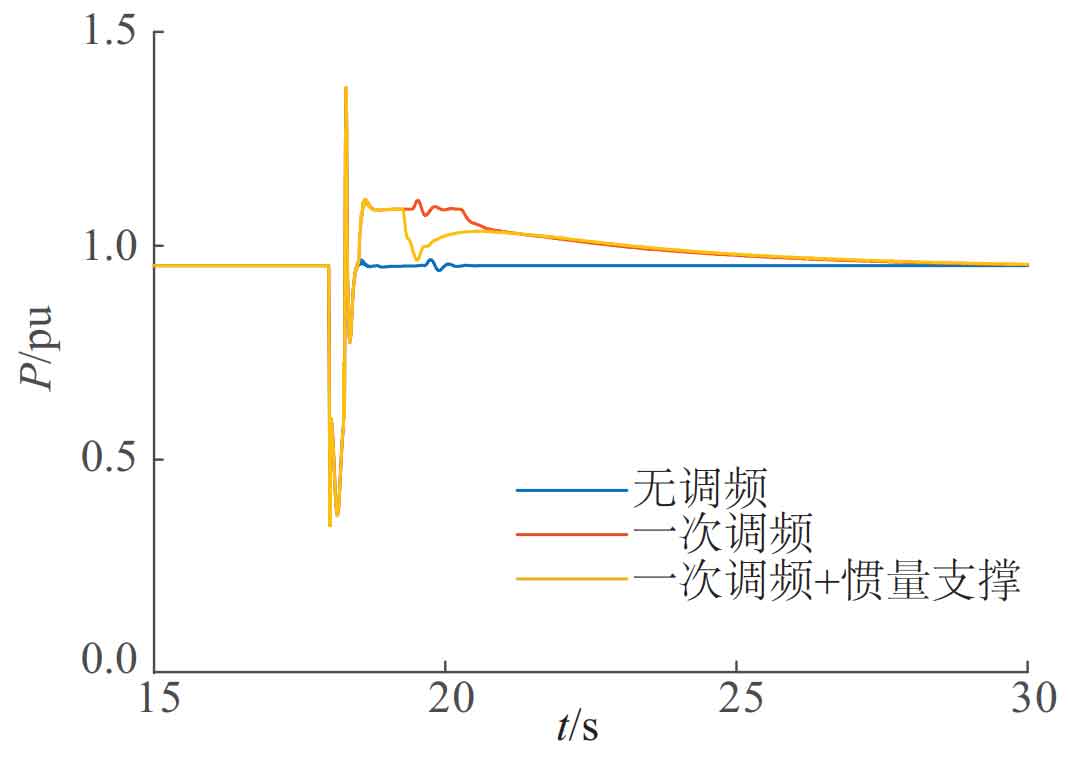
Based on Figures 14 and 15, it can be seen that after the fault occurred, the system voltage and frequency suddenly dropped. After 250 ms, the voltage immediately recovered, but the frequency continued to decrease until reaching the lowest point before starting to rise. This is because the exciter can instantly excite, respond quickly, and the voltage can be immediately restored. The response time of the governor is long, and there is inertia in the rotor rotation, resulting in a longer time scale for frequency recovery.
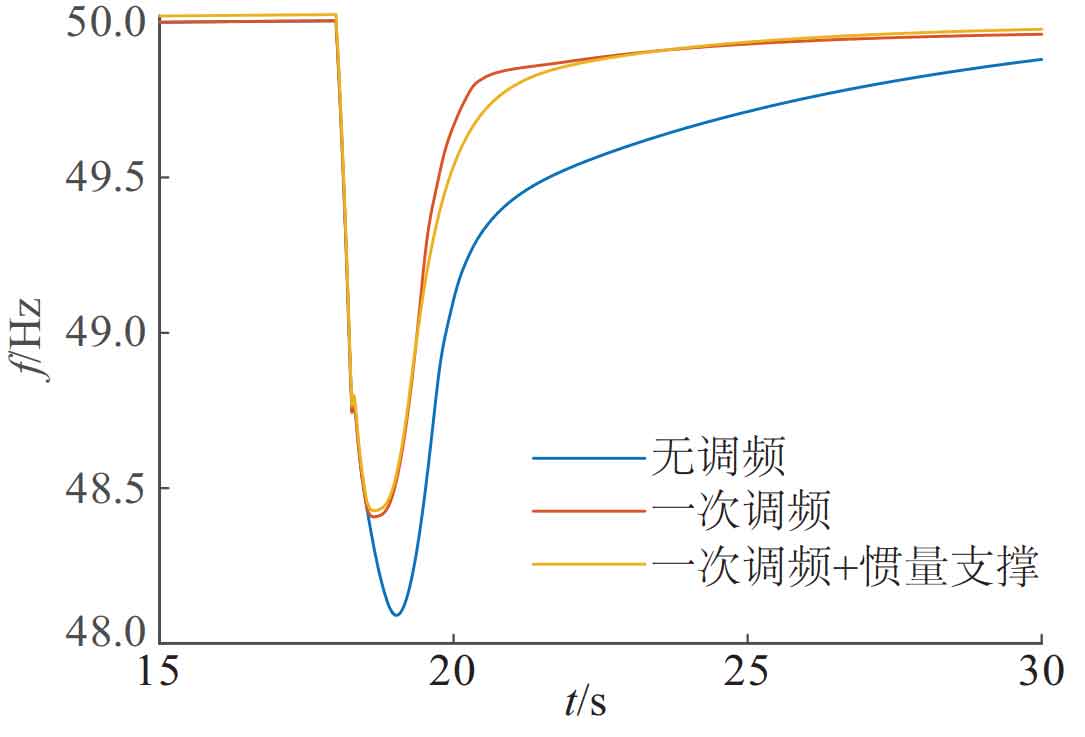
From Figures 16 to 18, it can be seen that after the system suffers a fault, the voltage drops severely, and the frequency drop amplitude exceeds the frequency modulation dead band. The photovoltaic inverter adopts low voltage ride through control, and the energy storage can also immediately participate in frequency modulation.
Comparing the frequency response curves under different control strategies in Figure 15, it can be seen that none of the three control strategies had a frequency modulation effect during the fault period, and the frequency response was consistent. After the fault is cleared, the lowest frequency point and stable frequency value under the two control strategies of energy storage participating in frequency regulation are higher than those under the control strategy of energy storage not participating in frequency regulation. Energy storage assisted photovoltaic unit frequency regulation is beneficial for improving system frequency stability. During the fault recovery and frequency recovery stages, the frequency recovery rate under the primary frequency regulation control strategy of the energy storage auxiliary photovoltaic unit is higher than that under the primary frequency regulation and inertia support control strategies of the energy storage auxiliary photovoltaic unit. This is because inertia plays a role in preventing frequency changes. When the frequency rises to a certain level, the energy storage device that provides inertia support will actually reduce active output and prevent rapid recovery of frequency, as shown in Figures 16 to 18.
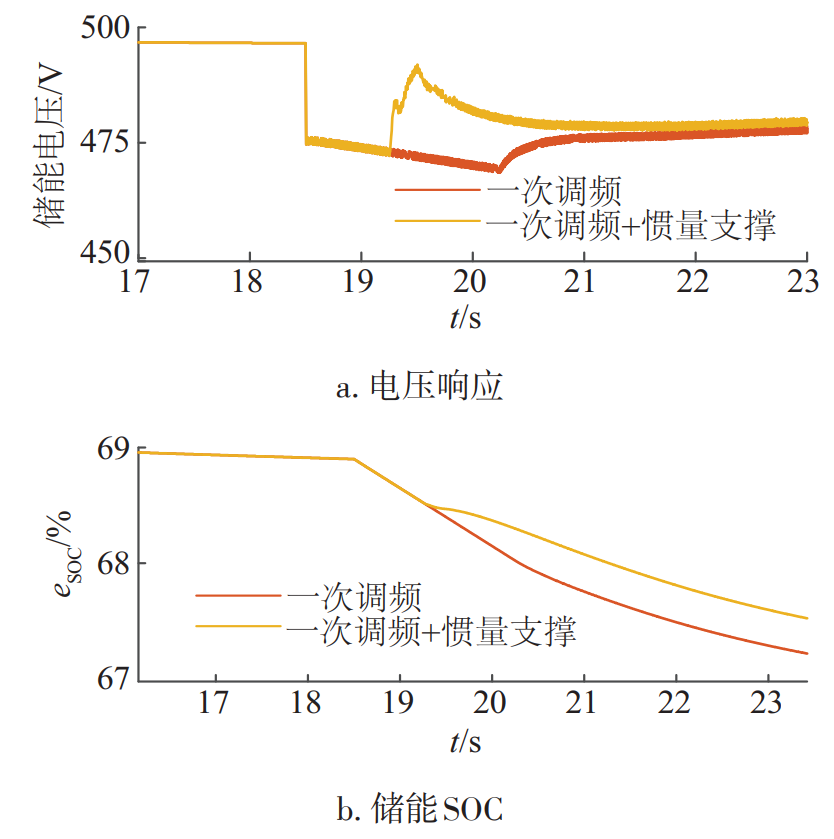
Through analysis, it can be concluded that energy storage assisted photovoltaic unit frequency regulation can significantly improve the frequency stability of the power grid during faults. Among them, the control strategy of energy storage assisted photovoltaic unit only performing one frequency regulation is more conducive to rapid recovery of system frequency under faults. Therefore, in order to quickly recover frequency and improve system frequency stability after a system failure, a control strategy of energy storage assisted primary frequency regulation of photovoltaic units should be adopted.
2.4 Quantitative Evaluation of Frequency Response
| Photovoltaic penetration rate/% | 0 | 33 | 66 |
| This article improves frequency indicators | 0.9872 | 0.9846 | 0.9808 |
According to the requirements of the guidelines for safe and stable operation of the power system, the duration of the system frequency below 49.5 Hz in emergency situations shall not exceed 10 minutes, and the first round action value of the system low-frequency load shedding protection is 49 Hz, with a delay of 0.2 seconds; Construct transient frequency stability margin indicators and quantitatively evaluate the frequency response under various simulation scenarios, as shown in Tables 4 to 7.
| Energy storage control strategy | No frequency modulation | Primary frequency modulation | Primary frequency modulation+inertia support |
| This article improves frequency indicators | 0.9808 | 0.9918 | 0.9920 |
From Tables 4 and 6, it can be seen that when there is no energy storage auxiliary photovoltaic unit frequency regulation, the frequency indicators in each scenario decrease with the increase of photovoltaic permeability. This indicates that as the photovoltaic permeability increases, the system frequency stability deteriorates, and the transient frequency response of the system becomes less ideal when subjected to the same load fluctuations or fault disturbances. The frequency indicators in the three penetration scenarios in Table 6 are all negative, indicating that the system has experienced frequency instability. This is because the frequency has dropped below 49 Hz, which can easily trigger the low-frequency load shedding protection action in the system and cause power outage accidents.
| Photovoltaic penetration rate/% | 0 | 33 | 66 |
| This article improves frequency indicators | -3.0588 | -6.0979 | -12.0301 |
From Tables 5 and 7, it can be seen that regardless of the energy storage control strategy used, the frequency index values of systems with energy storage assisted frequency regulation are higher than those without energy storage assisted frequency regulation. This indicates that energy storage assisted photovoltaic unit frequency regulation can improve system frequency stability. From Table 7, it can be seen that under fault conditions, the system frequency index values for primary frequency regulation and inertia support of energy storage auxiliary photovoltaic units are slightly lower than the system frequency index values for energy storage only auxiliary photovoltaic units. This indicates that under fault conditions, inertia will hinder the rebound of frequency, which is not conducive to improving transient frequency stability. On the contrary, from Table 5, it can be seen that under load fluctuations, the system frequency index values of primary frequency regulation and inertia support for energy storage auxiliary photovoltaic units are slightly higher than those for energy storage only auxiliary photovoltaic units. This indicates that under load fluctuation conditions, inertia support can prevent frequency fluctuations and improve the frequency stability of the system. Comparing the frequency index values of primary frequency regulation and inertia support for energy storage auxiliary units in Table 5 with the system frequency index values of 0% photovoltaic permeability in Table 4, it can be seen that when the system is subjected to the same load fluctuation disturbance, primary frequency regulation and inertia support for energy storage auxiliary photovoltaic units can significantly improve the transient frequency stability of high permeability photovoltaic systems. By setting reasonable energy storage frequency regulation parameters, The frequency stability of a high permeability photovoltaic system can be achieved, which is equivalent to that of a fully synchronous generator set (i.e. a photovoltaic penetration rate of 0%). Therefore, the above simulation results verify the effectiveness of the energy storage assisted photovoltaic unit frequency modulation control strategy proposed in this paper.
| Energy storage control strategy | No frequency modulation | Primary frequency modulation | Primary frequency modulation+inertia support |
| This paper improves the frequency index | -12.0301 | -7.1648 | -7.2072 |
3.Conclusion
To improve the frequency stability of high permeability photovoltaic systems, this paper uses supercapacitor energy storage to assist in photovoltaic frequency modulation, and proposes a frequency modulation control strategy that is suitable for both power fluctuations and fault disturbance conditions. The main conclusions are as follows:
1) By observing the operating curves of photovoltaic units under different operating conditions, it can be seen that the participation of energy storage in frequency modulation control hardly affects the DC bus voltage, and thus does not affect the output characteristics of photovoltaic units during fault traversal. However, with the increase of photovoltaic penetration rate, the system stability decreases, and the corresponding photovoltaic unit operation trajectory and fluctuation range are larger, mainly manifested in the right part of the maximum power point.
2) After the system is disturbed by a sudden increase in load, the system frequency will experience a drop phenomenon. As the permeability increases, the depth and rate of frequency drop increase, while the quasi steady state frequency decreases. The proposed control strategy provides primary frequency modulation power and inertia support power through energy storage assisted primary frequency modulation and inertia frequency modulation of photovoltaic units, which can reduce quasi steady-state frequency deviation and suppress rapid frequency drop, thereby improving system frequency stability.
3) After the fault occurs, both the system voltage and frequency experience a drop phenomenon. As the permeability increases, the depth of frequency drop increases, and the rate of frequency recovery to normal values slows down. Based on the low voltage ride through characteristics and system frequency response characteristics of photovoltaic units, it can be seen that during the fault period, the frequency drops and the voltage drops are severe. The photovoltaic unit needs to provide dynamic reactive power support to the power grid, but the active power cannot be sent out. During the fault recovery stage, the frequency can recover to normal operating values. The proposed control strategy utilizes energy storage to assist the photovoltaic unit in performing primary frequency regulation during the fault recovery phase, achieving a reduction in frequency drop depth and rapid frequency recovery, thereby improving system frequency stability.

